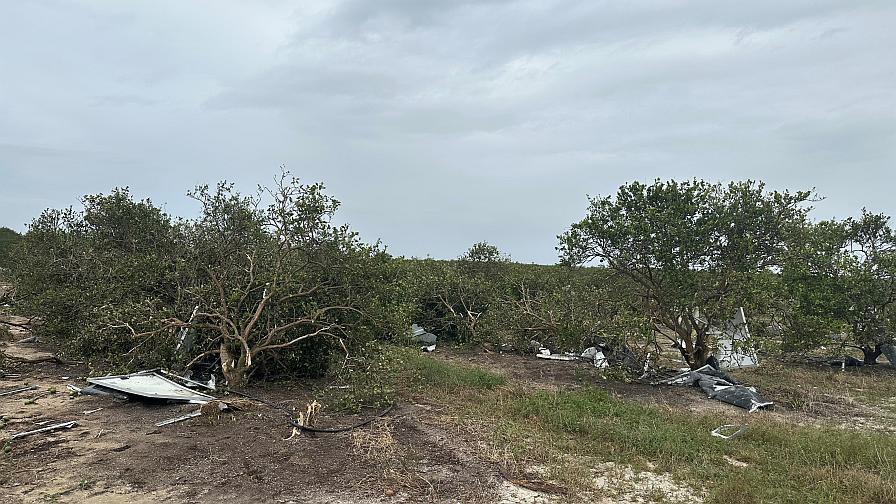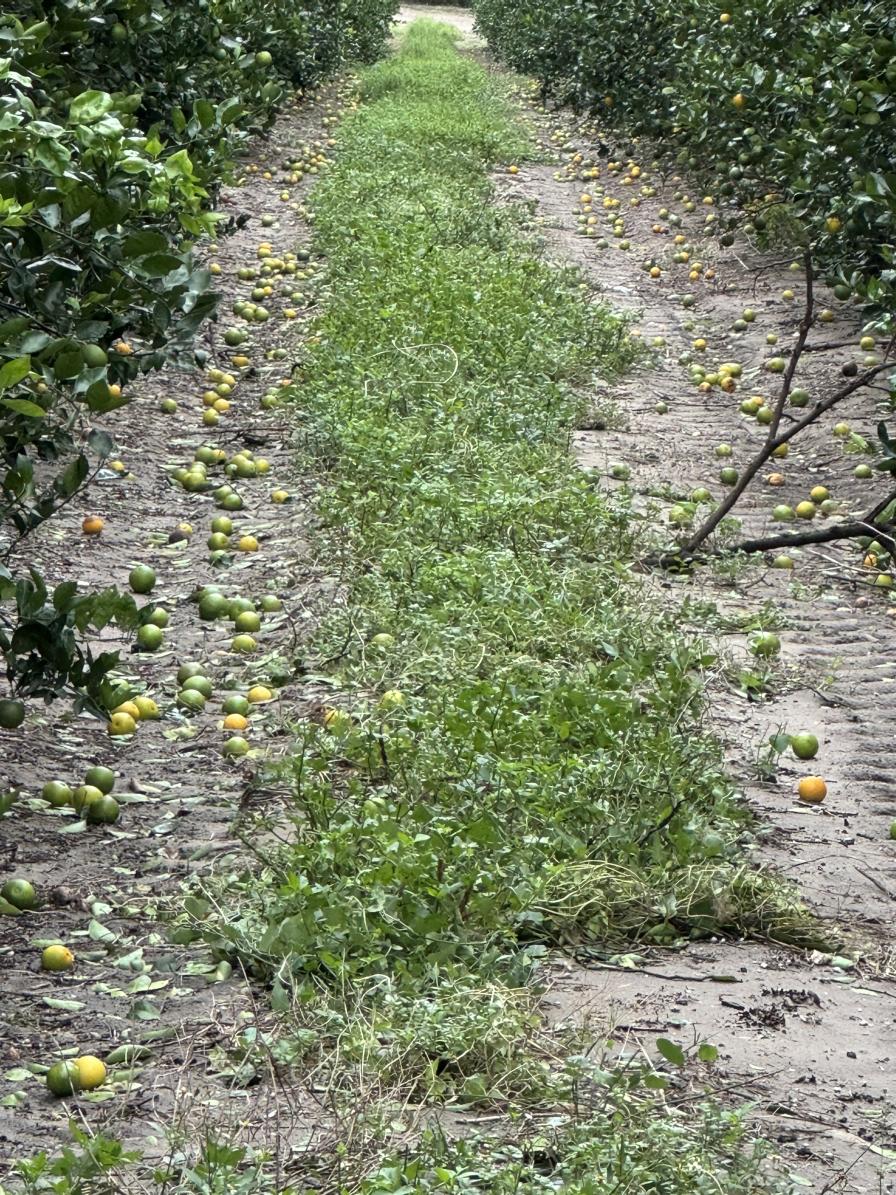Double Whammy! How Farmers Are Coping After Big Hurricane Hits

This citrus grove just north of Lake Placid, FL, sustained substantial damage from a tornado spawned during Hurricane Milton’s assault on Florida. Trees and fruit not entirely taken out will likely display storm-related stress symptoms in the coming weeks and months.
Photo courtesy of Ray Royce
The 2024 Atlantic hurricane season was forecast to be extremely active. The predictions have come to fruition, especially in the last few weeks. “All it takes is one ..” is a phrase often used to describe the perils of living in hurricane country. I’ve heard and relayed that phrase plenty over recent years. For many this hurricane season, that “one” has given way to multiple. Florida has taken on three hurricane landfalls since August (Debby, Helene, and Milton). Farm operations in Florida still recovering from major Hurricane Helene, are now left to deal with what major Hurricane Milton left in its wake.
Milton brought not only high winds and devastating surge and flooding to already saturated areas, but also spawned numerous damaging tornadoes ahead of its core. The eyewall trekked across highly populated areas of the Sunshine State. Growers who might have escaped the brunt of Helene weren’t as lucky with Milton. Florida’s main citrus production region comes to mind.
I reached out to Ray Royce, Executive Director of the Highlands County Citrus Growers Association. He says while groves in the area did feel effects from Hurricane Milton, damages vary in severity.
“Hurricane Milton did not cause any significant tree loss or damage in Highlands County (other than in several groves hit by an associated tornado), Royce says. “Though it is likely that we will see trees expressing symptoms of storm stress in the coming days and weeks.”
He continues, “Immediate fruit loss was obviously dependent on how close the groves were to the highest hurricane force winds with more loss in the northern sections of the county than in groves south of Lake Placid. Early varieties, due to being larger and more mature, had higher fruit loss rates than Valencias.”
Florida Citrus Mutual Executive VP and CEO Matt Joyner says, Hurricane Milton caused significant damage across the state’s main citrus belt. “In the impacted areas, growers are reporting substantial losses of their crop from fruit blown off the trees, broken limbs, damaged leaves, and toppled trees.”
This past Friday (Oct. 11), USDA released its first Florida citrus crop forecast for the 2024-2025 season. The all-orange estimate is at 15 million boxes. That figure is 16% down from last season’s total, according to USDA. The forecast for all-grapefruit production is 1.4 million boxes (22% lower than last season’s actual of 1.79 million). Keep in mind, these early estimates are not taking Hurricane Milton into account yet.
“It is almost certain that subsequent USDA forecast updates in December and after that will be lowered due to storm impacts,” Royce adds.
When I asked Royce to compare Milton to that of Hurricane Ian’s impacts on Florida citrus in 2022, he says there is no comparison. “No doubt that Hurricane Ian two years ago caused much more immediate fruit loss and tree damage than Milton did, at least in our area.”
Joyner points out no matter the name or when and where they hit, these storms have had a cumulative effect. “These compounding challenges of citrus greening and hurricanes Irma, Ian, Nicole, and now Milton, the challenges are really stacking up. While Florida’s citrus growers are resilient, they will need support from state and federal partners to help rebuild their groves and this industry.”

This citrus grove was left shaken after Hurricane Milton. This scene was a familiar one for Polk, Hardee, and Highlands counties in Florida following the major storm.
Photo courtesy of Florida Citrus Mutual
The Florida Fruit and Vegetable Association released an official statement the day following Hurricane Milton’s passage: “It is hard to imagine Florida would navigate the recovery process from two major hurricanes simultaneously this season. And once again, we are reminded of the strength and resiliency of Florida’s agricultural industry.
“While Florida growers begin to assess the extent of any personal or operational impacts from Hurricane Milton, we are grateful to hear that everyone appears to be safe, and there has been no loss of life in our agricultural communities. As growers return to the fields and evaluate their crops, it may take several weeks before the full impacts are known. If there are any, the effects can vary greatly by crop, geography and even by field location within the same area.”
Storms Taking a Toll on Agriculture
Late last week, the University of Georgia College of Agriculture and Environmental Sciences announced the preliminary estimate of Hurricane Helene’s economic impact on Georgia agriculture at $6.46 billion. In the meantime, University of Florida’s Food and Resource Economics Department is still conducting ag damage assessment analyses for Helene and now Milton. Ag producers are encouraged to complete the Economic Impact Analysis Program (EIAP) surveys to provide a true picture of damages caused by these storms. This helps when it comes time for government agencies to allocate disaster relief funds.
The preliminary UF/IFAS EIAP report related to agricultural production losses in Florida due to Hurricane Debby include an estimated value between $93.7 million and $263.2 million.
Roads To Recovery
Florida Commissioner of Agriculture Wilton Simpson has announced local farmers impacted by Hurricane Milton can now apply for interest-free loans through the Agriculture and Aquaculture Producers Natural Disaster Recovery Loan Program. This entails:
- Interest-free loans up to $500,000 for eligible agriculture and aquaculture producers that have experienced damage or destruction from Hurricane Milton.
- Loans may be used to restore, repair, or replace essential physical property, including fences, equipment, greenhouses, and other buildings, or to remove vegetative debris.
Interested producers can learn more or apply here.
In addition, producers that were previously awarded funds for damages sustained from Hurricane Debby and/or Hurricane Helene might be eligible to apply for damage sustained from Milton, too. An applicant may not receive more than one loan per storm, more than two loans per year, or more than five loans in any three-year period.
Documenting Loss
Document damages and losses your operation has sustained as best you can, including gathering farm records, receipts and pictures of damages or losses.
Reporting Loss
Once you are able to safely evaluate the impact on your operation, contact your local USDA Farm Service Agency (FSA) county office or your crop insurance agent to report all crop and farm infrastructure damages and losses. For producers who have risk protection through Federal Crop Insurance, the USDA Risk Management Agency has authorized Approved Insurance Providers to provide flexibility on reporting requirements for those who are unable to report losses due the disaster.
More Key Disaster Recovery Resources and Tools
Learn more about programs available for producers at farmers.gov, including the Disaster Assistance Discovery Tool, Disaster-at-a-Glance fact sheet, and Farm Loan Assistance Tool.
A Helping Hand After the Storm
The Florida Farm Bureau Federation has established a hurricane relief fund designed to help the state’s farmers and ranchers directly affected by the 2024 Atlantic hurricane season. The industry organization says anyone can donate to its Hurricane Relief Fund for Agriculture. Click here to learn more.
This story is developing and will be updated with new information as it comes in.









